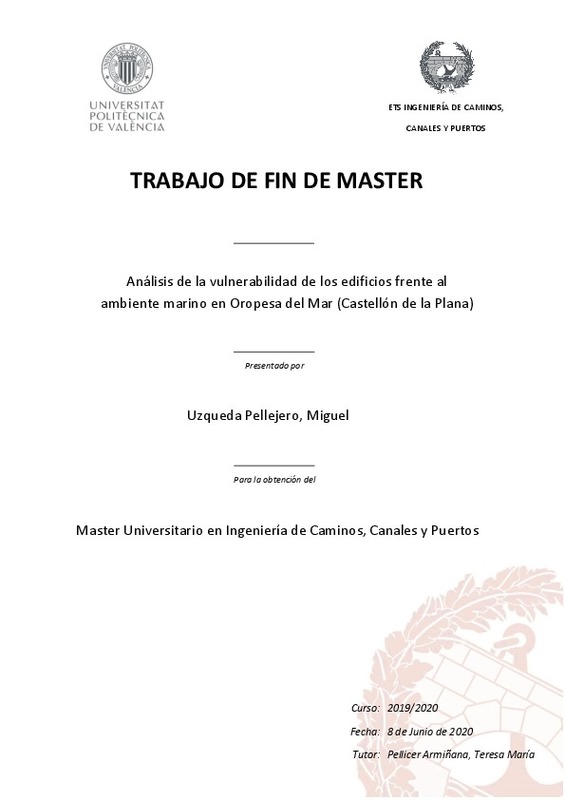|
Resumen:
|
[ES] La vulnerabilidad de las construcciones frente a agentes externos, es un tema que cuenta con varias líneas de investigación. En el caso de la agresividad del ambiente costero, hay numerosos daños provocados por este ...[+]
[ES] La vulnerabilidad de las construcciones frente a agentes externos, es un tema que cuenta con varias líneas de investigación. En el caso de la agresividad del ambiente costero, hay numerosos daños provocados por este fenómeno, que pueden llegar a causar problemas en una estructura, principalmente a causa de la corrosión en las armaduras. Por este motivo, el objeto de este trabajo consiste en el conocimiento de los agentes que pueden ocasionar daños en las edificaciones situadas junto al litoral marítimo y cuál es la reacción de los edificios frente a estas acciones.
Tras conocer dichos agentes y de qué manera afectan sobre una estructura, se exponen los diversos factores a tener en cuenta, que influyen en mayor o menor medida sobre el deterioro de los edificios y con ello, el estudio de la vulnerabilidad de los mismos. Variables como la distancia entre la orilla del mar y el edificio, la velocidad e intensidad del viento o el tipo de revestimiento de fachada, nos pueden dar a conocer información sobre la capacidad de la construcción a soportar las partículas agresivas del aerosol marino.
Una vez se han estudiado modelos de cálculo y conocimiento de vulnerabilidades en otros casos, como en análisis frente a sismos o inundaciones, se han trasladado dichos conocimientos y se ha adaptado al estudio frente al ambiente marino.
Para poder ejecutar dicho estudio, se ha llevado a cabo la inspección visual de una serie de edificaciones en la población costera de Oropesa del Mar. La información recogida se ha plasmado en unas fichas técnicas y que, posteriormente, se vuelcan los datos obtenidos sobre las tablas Excel. En cada edificio se analizan los factores de vulnerabilidad que se tienen en cuenta en este estudio y se aplica un valor para ponderar cada uno de estos agentes, según sean más o menos perjudiciales y que se podrían extrapolar a otras localidades costeras.
Tras conocer el estado de los edificios, se recogen los diferentes daños encontrados y las patologías que pueden sufrir si continúa la agresión, para posteriormente analizar una serie de actuaciones de mejora que puedan reducir en un futuro el impacto de los daños más habituales.
Por último, en las conclusiones se aportan los resultados obtenidos por el análisis de vulnerabilidad, en el que se muestra qué fenómenos o condicionantes generan mayores problemas sobre las construcciones, a causa de la agresividad que provoca el ambiente marino sobre estas.
[-]
[EN] The vulnerability of constructions against external agents is a subject that has several lines of research. In the case of the aggressiveness of the coastal environment, there are numerous damages caused by this ...[+]
[EN] The vulnerability of constructions against external agents is a subject that has several lines of research. In the case of the aggressiveness of the coastal environment, there are numerous damages caused by this phenomenon, which can cause problems in a structure, mainly due to corrosion in the reinforcements. For this reason, the purpose of this work is to find out about the agents that can cause damage to buildings located along the seafront and what the buildings' reaction is to these actions.
After knowing these agents and how they affect to the structures, factors to be taken into account are exposed, which influence to a greater or lesser extent the deterioration of buildings and with it, the study of their vulnerability. Variables such as the distance between the seashore and the building, the speed and intensity of the wind or the type of facade, can give us information on the ability of the construction to resist the aggressive particles of the marine spray.
Once calculation models and knowledge of vulnerabilities have been studied in other cases, such as analysis against earthquakes or floods, this knowledge has been transferred and adapted to the study against the marine environment.
In order to carry out this study, a visual inspection of a series of buildings in the coastal town of Oropesa del Mar has been carried out. The information collected has been reflected in technical sheets and, subsequently, the data obtained on the Excel tables. In each building, the vulnerability factors that are taken into account in this study are analysed and value is applied to weigh each of these agents, depending on whether they are more or less harmful and that could be extrapolated to other coastal localities.
After knowing the state of the buildings, the different damages found and the pathologies that may be suffered if the aggression continues are collected, and then a series of improvement actions that may reduce the impact of the most common damages in the future are analysed.
Lastly, the conclusions provide the results obtained from the vulnerability analysis, which shows which phenomenon or constraints generate the greatest problems on the buildings, due to the aggressiveness caused by the marine environment on them.
[-]
|





![PDF file [Pdf]](/themes/UPV/images/pdf.png)


